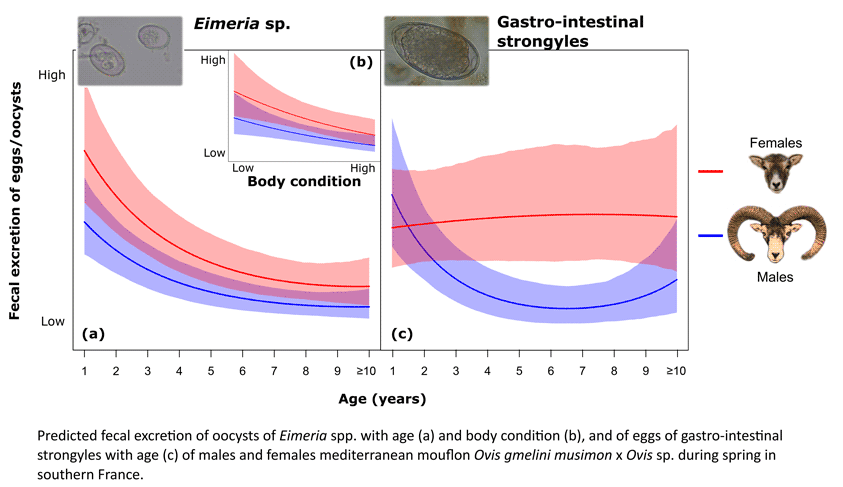Crossref Citations
This article has been cited by the following publications. This list is generated based on data provided by
Crossref.
Beaumelle, Camille
Redman, Elizabeth M.
de Rijke, Jill
Wit, Janneke
Benabed, Slimania
Debias, François
Duhayer, Jeanne
Pardonnet, Sylvia
Poirel, Marie-Thérèse
Capron, Gilles
Chabot, Stéphane
Rey, Benjamin
Yannic, Glenn
Gilleard, John S.
and
Bourgoin, Gilles
2021.
Metabarcoding in two isolated populations of wild roe deer (Capreolus capreolus) reveals variation in gastrointestinal nematode community composition between regions and among age classes.
Parasites & Vectors,
Vol. 14,
Issue. 1,
Kapnisis, Kypros
Kassinis, Nikolaos
Papanikolopoulou, Vasiliki
and
Diakou, Anastasia
2022.
Endoparasites in wild populations of Cyprus mouflon (Ovis gmelini ophion).
Veterinary Parasitology: Regional Studies and Reports,
Vol. 34,
Issue. ,
p.
100767.
Bangoura, Berit
Bhuiya, Md Ashraful Islam
and
Kilpatrick, Michelle
2022.
Eimeria infections in domestic and wild ruminants with reference to control options in domestic ruminants.
Parasitology Research,
Vol. 121,
Issue. 8,
p.
2207.
Garel, Mathieu
Marchand, Pascal
Bourgoin, Gilles
Santiago-Moreno, Julián
Portanier, Elodie
Piegert, Holger
Hadjisterkotis, Eleftherios
and
Cugnasse, Jean-Marc
2022.
Terrestrial Cetartiodactyla.
p.
487.
Garel, Mathieu
Marchand, Pascal
Bourgoin, Gilles
Santiago-Moreno, Julián
Portanier, Elodie
Piegert, Holger
Hadjisterkotis, Eleftherios
and
Cugnasse, Jean-Marc
2022.
Handbook of the Mammals of Europe.
p.
1.
Zduniak, Milena
Serafini, Sarah
Wróbel, Aleksandra
and
Zwolak, Rafał
2023.
Host body mass, not sex, affects ectoparasite loads in yellow-necked mouse Apodemus flavicollis.
Parasitology Research,
Vol. 122,
Issue. 11,
p.
2599.
Davey, Marie L.
Kamenova, Stefaniya
Fossøy, Frode
Solberg, Erling J.
Davidson, Rebecca
Mysterud, Atle
and
Rolandsen, Christer M.
2023.
Faecal metabarcoding provides improved detection and taxonomic resolution for non-invasive monitoring of gastrointestinal nematode parasites in wild moose populations.
Parasites & Vectors,
Vol. 16,
Issue. 1,
Hasapis, Kyriacos A.
Charalambidou, Iris
Schou, Chad
O’Dowd Phanis, Catherine
Kazamia, Stefanie
Kassinis, Nicolaos
Hadjisterkotis, Eleftherios
and
Karanis, Panagiotis
2024.
First Detection of Cryptosporidium parvum in the Endemic Cyprus Mouflon (Ovis gmelini ophion).
Acta Parasitologica,
Vol. 69,
Issue. 1,
p.
1035.
Bariod, Léa
Saïd, Sonia
Calenge, Clément
Scheifler, Renaud
Fritsch, Clémentine
Peroz, Carole
Benabed, Slimania
Bidault, Hervé
Chabot, Stéphane
Débias, François
Duhayer, Jeanne
Pardonnet, Sylvia
Poirel, Marie‐Thérèse
Revelli, Paul
Vuarin, Pauline
and
Bourgoin, Gilles
2024.
Essential mineral elements in roe deer: Associations with parasites and immune phenotypes in two contrasting populations.
Ecology and Evolution,
Vol. 14,
Issue. 10,
Beaumelle, Camille
Toïgo, Carole
Papet, Rodolphe
Benabed, Slimania
Beurier, Mathieu
Bordes, Léa
Brignone, Anaïs
Curt-Grand-Gaudin, Nadine
Garel, Mathieu
Ginot, Justine
Jacquiet, Philippe
Miquel, Christian
Poirel, Marie-Thérèse
Serafino, Anna
Vannard, Eric
Bourgoin, Gilles
and
Yannic, Glenn
2024.
Cross-transmission of resistant gastrointestinal nematodes between wildlife and transhumant sheep
.
Peer Community Journal,
Vol. 4,
Issue. ,
